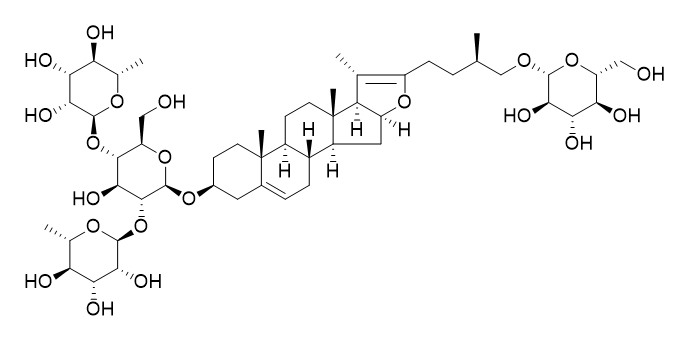Pseudoprotodioscin
Pseudoprotodioscin exhibits anti-inflammatory and anticancer activities, it shows a weaker suppressing effect on the production of inflammatory cytokines, and can suppress melanogenesis in B16F1 cells.
Inquire / Order:
manager@chemfaces.com
Technical Inquiries:
service@chemfaces.com
Tel:
+86-27-84237783
Fax:
+86-27-84254680
Address:
1 Building, No. 83, CheCheng Rd., Wuhan Economic and Technological Development Zone, Wuhan, Hubei 430056, PRC
Providing storage is as stated on the product vial and the vial is kept tightly sealed, the product can be stored for up to
24 months(2-8C).
Wherever possible, you should prepare and use solutions on the same day. However, if you need to make up stock solutions in advance, we recommend that you store the solution as aliquots in tightly sealed vials at -20C. Generally, these will be useable for up to two weeks. Before use, and prior to opening the vial we recommend that you allow your product to equilibrate to room temperature for at least 1 hour.
Need more advice on solubility, usage and handling? Please email to: service@chemfaces.com
The packaging of the product may have turned upside down during transportation, resulting in the natural compounds adhering to the neck or cap of the vial. take the vial out of its packaging and gently shake to let the compounds fall to the bottom of the vial. for liquid products, centrifuge at 200-500 RPM to gather the liquid at the bottom of the vial. try to avoid loss or contamination during handling.
J Mater Chem B.2019, 7(39):5896-5919
Bull. Pharm. Sci., Assiut University2020, 43(2):149-155.
Plant Foods Hum Nutr.2021, 76(4):472-477.
Biomed Pharmacother.2024, 179:117346.
TCI CO.2019, US20190151281A1
J Ethnopharmacol.2020, 249:112396
Processes2021, 9(11),2065.
Microchemical Journal2014, 203:110804.
Viruses.2024, 16(7):1128.
Int. J. Mol. Sci.2022, 23(19), 11900.
Related and Featured Products
Planta Med. 2011 May;77(7):705-10.
Anti-inflammatory and anti-melanogenic steroidal saponin glycosides from Fenugreek (Trigonella foenum-graecum L.) seeds.[Pubmed:
20979021 ]
Fenugreek seed ( Trigonella foenum-graecum L.) is used as an herbal medicine for treating metabolic and nutritive dysfunctions.
METHODS AND RESULTS:
To determine if this plant has other beneficial effects, we tested the inhibitory activities of a methanol (MeOH) extract of fenugreek seed on the production of inflammatory cytokines and melanin synthesis in cultured cell lines in vitro. The MeOH extract inhibited the production of phorbol-12-myristate-13-acetate-induced inflammatory cytokines such as tumor necrosis factor (TNF)-α in cultured THP-1 cells, and also restrained the intracellular synthesis of melanin in murine melanoma B16F1 cells. We isolated three active constituents from fenugreek seed extracts. These were identified as the steroidal saponins 26- O-β-D-glucopyranosyl-(25 R)-furost-5(6)-en-3 β,22 β,26-triol-3- O-α-L-rhamno-pyranosyl-(1'' → 2')-O-[β-D-glucopyranosyl-(1''' → 6')- O]-β-D-glucopyranoside 1, minutoside B 2, and Pseudoprotodioscin 3. Compounds 1 and 2 strongly suppressed the production of inflammatory cytokines, whereas 3 showed a weaker suppressing effect. Melanogenesis in B16F1 cells was significantly suppressed by 1 and 3, and weakly suppressed by 2. All three compounds showed moderate cytotoxicities.
CONCLUSIONS:
These results indicate that fenugreek extract and its active constituents could protect against skin damage.
Planta Med. 2001 Dec;67(9):853-7.
Two new steroidal saponins from the rhizomes of Dioscorea panthaica and their cytotoxic activity.[Pubmed:
11745024]
Two new steroidal saponins, dioscoresides C (1) and D (2), along with a new natural product, pregnadienolone 3-O-beta-gracillimatriose (3), and two known compounds, pregnadienolone 3-O-beta-chacotrioside (4) and Pseudoprotodioscin (5), were isolated from the rhizomes of Dioscorea panthaica Prain et Burkill.
METHODS AND RESULTS:
On the basis of extensive NMR studies and chemical evidence, dioscoresides C and D were determined to be 26-O-beta-D-glucopyranosyl-3 beta,26-dihydroxy-23(S)-methoxy-25(R)-furosta-5,20(22)-dien-3-O-alpha-L-rhamnopyranosyl-(1-->2)-[alpha-L-rhamnopyranosyl-(1-->4)]-beta-D-glucopyranoside and 26-O-beta-D-glucopyranosyl-3 beta,26-dihydroxy-20,22-seco-25(R)-furosta-5-en-20,22-dine-3-O-alpha-L-rhamnopyranosyl-(1-->2)-[alpha-L-rhamnopyranosyl-(1--> 4)]-beta-D-glucopyranoside.
CONCLUSIONS:
These compounds showed mild cytotoxicity against the cancer cell lines, A375, L929, and HeLa, in a dose-dependent manner.
Fitoterapia . 2019 Nov;139:104393.
Pseudoprotodioscin inhibits SREBPs and microRNA 33a/b levels and reduces the gene expression regarding the synthesis of cholesterol and triglycerides[Pubmed:
31669721]
Abstract
The extract of Dioscorea zingiberensis C.H. Wright rhizomes is found to be effective in the therapy of cardiovascular disease. Steroidal saponins make substantial contribution. Previous study has proposed that methylprotodioscin (MP) may promote cholesterol efflux by increasing ABCA1 expression. But the other main saponins ingredients are not referred to. The aim of the present work was to reveal the effect and mechanism of protodioscin (PD), MP and Pseudoprotodioscin (PPD) on the synthesis-related gene expression of cholesterol and triglycerides. MTT assay apoptosis assay with annexin AV-APC and 7-AAD double staining were performed. MicroRNA assay and qRT-PCR were used to analyze the gene expression which regulates synthesis of cholesterol and triglycerides. Western blot was to demonstrate the levels of target proteins. Cholesterol efflux assay was executed to study the stimulative effect of saponins on cholesterol efflux. In Hep G2 cells, PPD increased ABCA1 protein and mRNA levels, and promoted the effluxion of ApoA-1-mediated cholesterol. The underlying mechanisms involved that PPD inhibited SREBP1c and SREBP2 transcription by decreasing microRNA 33a/b levels. This procedure reciprocally led to the increase of ABCA1 levels. In THP-1 macrophages, PPD showed the similar effect, which reduced HMGCR, FAS and ACC mRNA levels and promoted low density lipoprotein receptor by decreasing the PCSK9 levels. These studies demonstrated that PPD is a potential agent for cholesterol efflux, SREBPs and microRNA 33a/b inhibition, which related to the gene expression for the synthesis of cholesterol and triglycerides.
Keywords: Dioscorea zingiberensis C.H. Wright; Low density lipoprotein; Pseudoprotodioscin; SREBPs; microRNA 33a/b.



